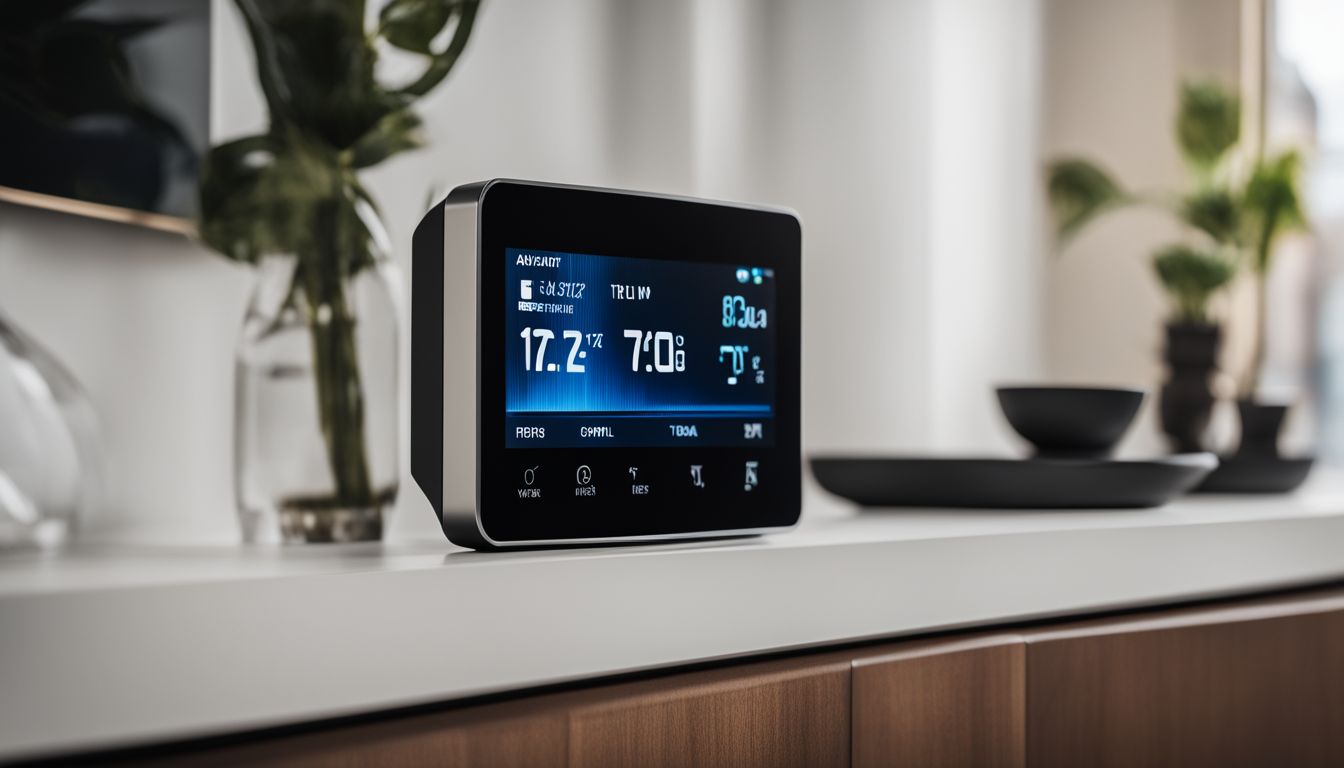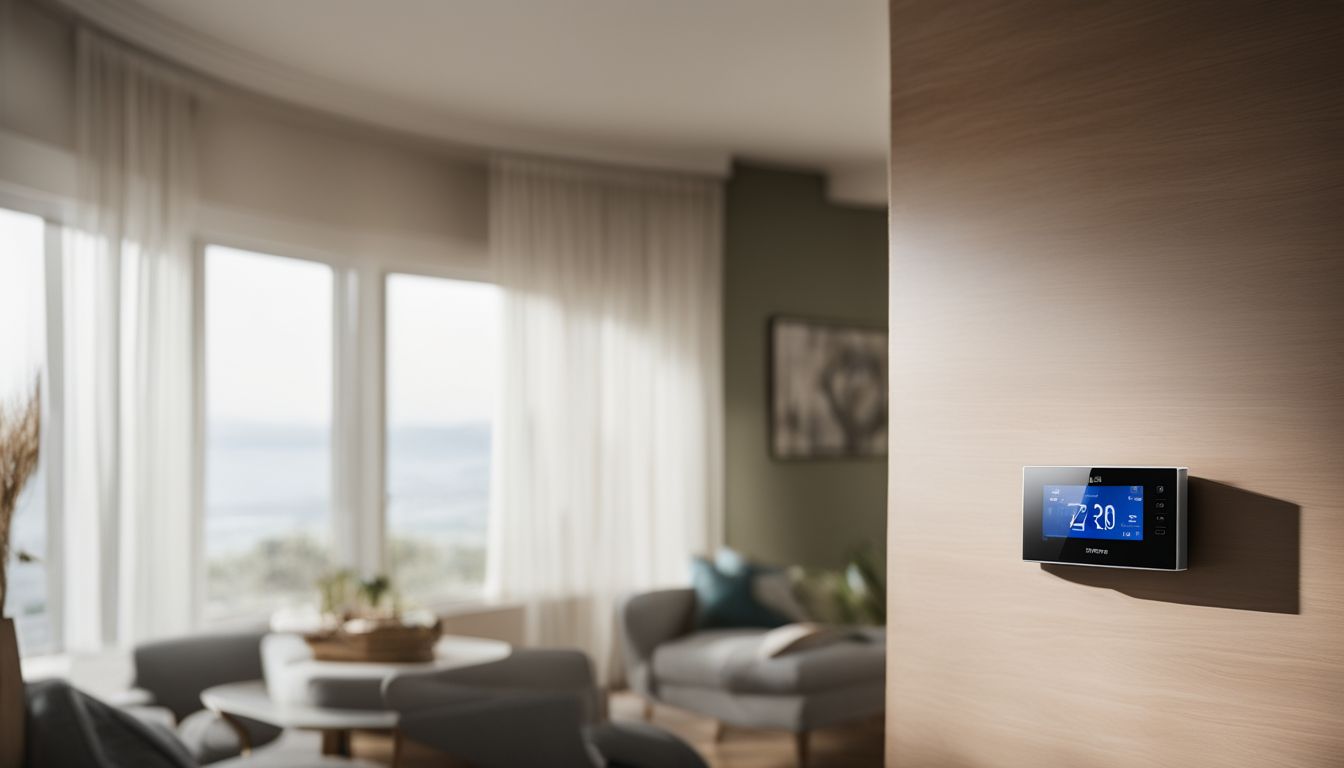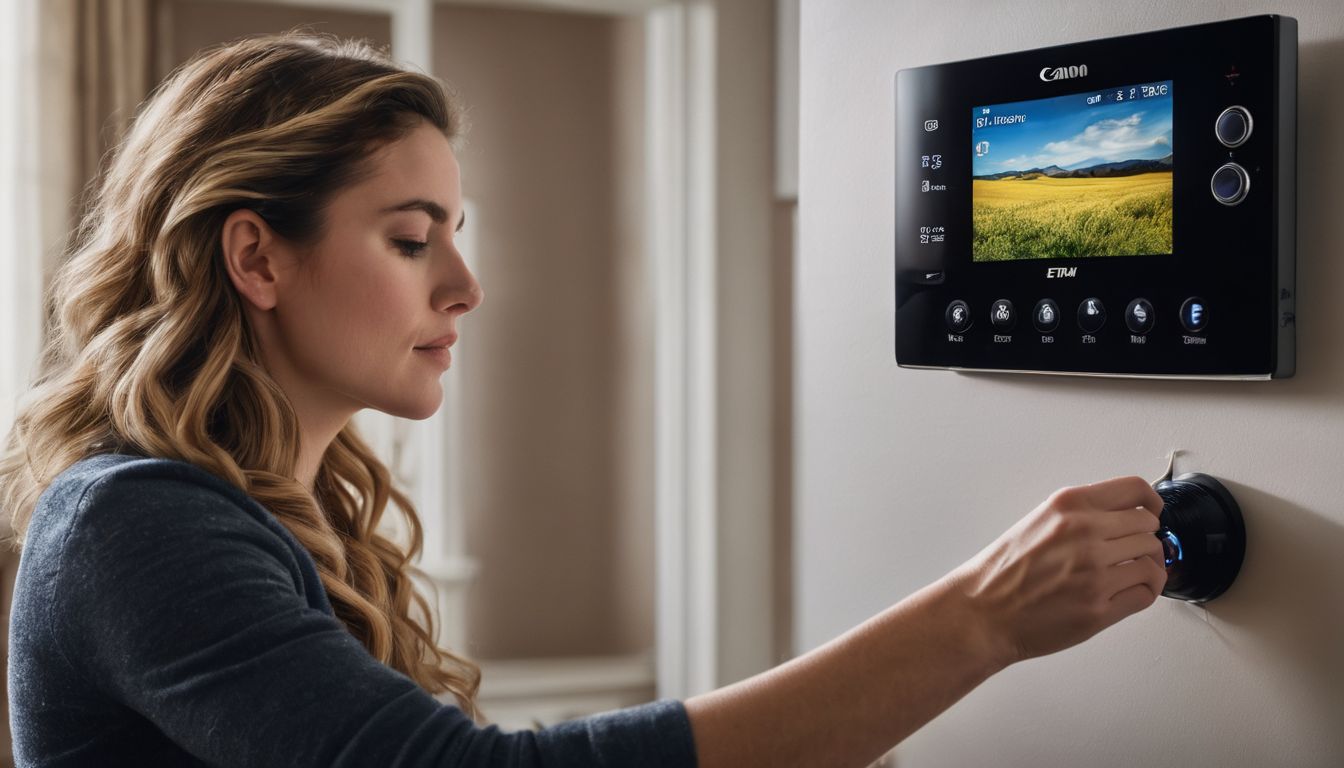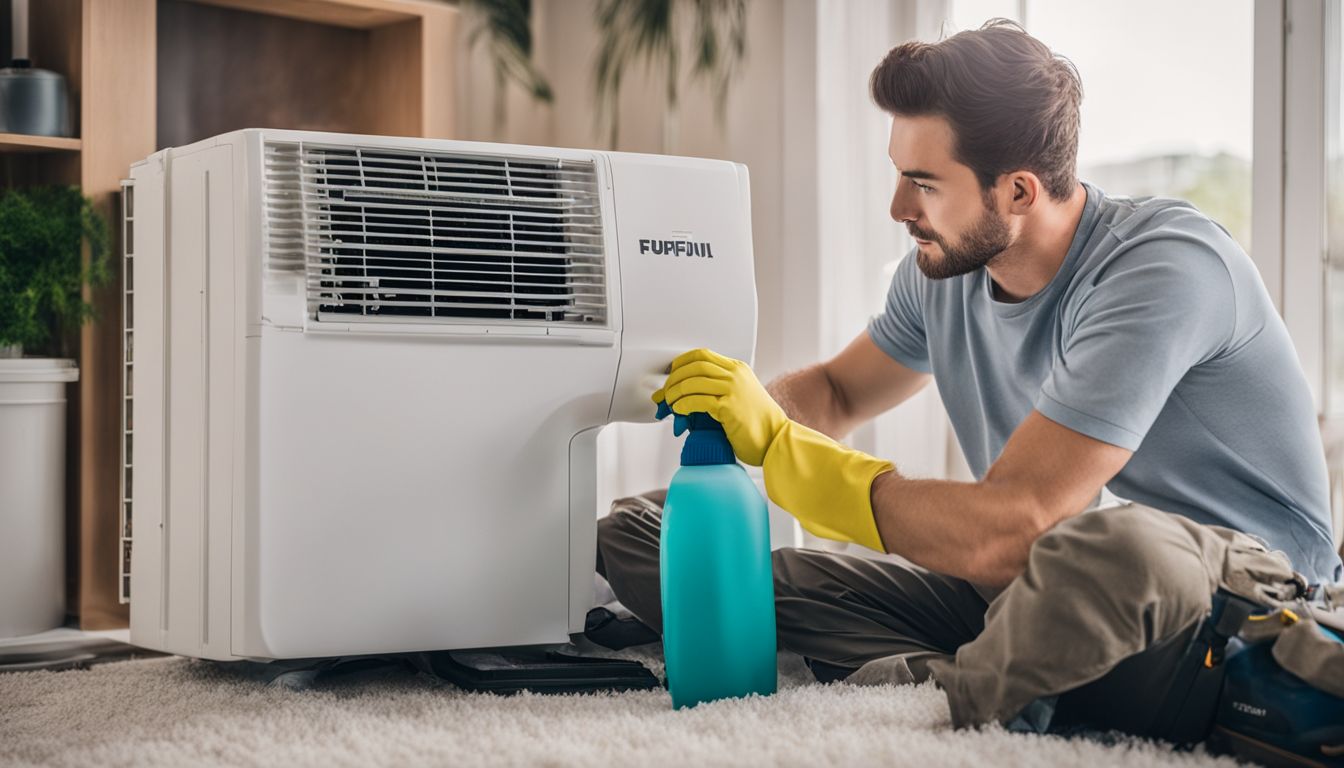Struggling to find that perfect balance of comfort and cost in your home? It’s a common dilemma faced by many when adjusting their thermostats. According to the US Department of Energy, 68 degrees Fahrenheit is key for energy savings during winter months.
Our guide walks you through setting your thermostat just right across all seasons, maximising your home’s cosiness without burning a hole in your pocket. Read on for easy temperature tips!
Understanding Thermostats
Thermostats are the brain of any heating and cooling system, letting you dictate indoor temperature with ease. They respond to your settings by turning your HVAC system on or off to maintain the desired climate in your home.
Modern advancements have introduced programmable thermostats, which offer customisable schedules for temperature adjustments throughout the day. This technology not only enhances comfort but can also lead to significant energy savings by reducing energy consumption when it’s least needed.
Smart thermostats take this a step further by learning your habits and adjusting automatically, integrating seamlessly with smart home systems for ultimate convenience. Homeowners benefit from being able to control their thermostats remotely via smartphones or tablets.
These devices often come with additional features such as energy usage reports and maintenance reminders, helping you stay on top of your home’s efficiency and ensuring optimal performance from your air conditioning or heat pump year-round. The Importance of Thermostat Settings

Setting your thermostat correctly plays a pivotal role in not just maintaining comfortable indoor temperatures, but also in ensuring energy efficiency throughout your home. Properly adjusting the settings according to the season can significantly reduce utility bills and enhance the performance of heating or cooling systems.
In Winter
As the mercury drops, setting your home’s thermostat to the right temperature can make a big difference to both comfort and energy bills. The U.S. Department of Energy recommends maintaining 68 degrees Fahrenheit inside your home during winter for optimal energy efficiency.
This helps keep you snug while conserving energy and reducing heating costs.
Keeping your house at this suggested temperature strikes a balance between staying warm and not overworking your heat pumps or boilers. It also aligns with sustainable living practices by cutting down on unnecessary energy use.
Remember, every degree lower in the heating season can trim around 1 per cent off your utility bill, according to experts in energy conservation.
In Summer
Keeping your home comfortably cool in summer while reducing cooling costs can be a fine balance to strike. The U.S. Department of Energy suggests that setting your thermostat to 78°F (26°C) when you’re home hits that sweet spot between energy efficiency and comfort.
This setting helps manage the house’s relative humidity, which can make higher temperatures feel more comfortable.
When leaving the house for extended periods, bumping up the temperature to 85 degrees ensures energy isn’t wasted on space but also safeguards against excessive heat that could damage electronics or furnishings.
Utilising ceiling fans during these months will promote air circulation and may allow for a higher thermostat setting without compromising on comfort. Be mindful not to exceed a setting of 90 degrees, as this runs the risk of building up too much moisture and heat within your home environment.
Ideal Thermostat Settings for Each Season
Discovering the perfect balance for your home’s climate control can be a seasonal symphony, where tailored thermostat settings harmonise with the changing weather to create energy-efficient comfort.
Whether you’re basking in summer warmth or cosying up during the winter chill, optimised temperatures not only enhance your living space but also contribute significantly to managing household energy consumption.
Recommended Thermostat Settings for Summer
During the hot summer months, conserving energy while keeping cool is key. The US Department of Energy suggests setting your thermostat at 78 degrees Fahrenheit throughout most of the day.
This temperature strikes a balance between comfort and energy efficiency, allowing you to stay refreshed without overworking your air conditioner.
Consider bumping up the temperature to around 85 degrees if you’re leaving home for a few hours. Not only does this prevent unnecessary cooling, but it also helps in reducing electricity prices by avoiding peak daytime energy rates.
Always ensure that temperatures don’t exceed 90 degrees even when away to avoid excessive heat build-up which can be hard on both your house plants and the system itself upon return.
Recommended Thermostat Settings for Winter
Set your thermostat to 68 degrees Fahrenheit in winter for optimal comfort and energy savings. This temperature balances keeping you warm while not overworking your heating system.
Experts, including those at the US Department of Energy, agree that maintaining this setting when you are awake and at home is effective in managing your energy bills. If everyone lowers their thermostat by just one degree, collectively we save a significant amount on national energy costs.
Consider lowering the temperature further overnight or when no one’s home to conserve even more energy. You can drop it by 10 to 15 degrees for periods of sleep or absence, which could lead to substantial reductions in your annual heating bill – up to 15 per cent according to some studies.
Such smart adjustments contribute both to individual savings and wider clean energy efforts by reducing demand on the grid and cutting down carbon emissions from power plants.
Recommended Thermostat Settings for Spring and Fall
As spring and autumn bring milder temperatures, adjusting your thermostat can lead to significant energy savings. During these seasons, set your heating down to 60 degrees when you’re out of the house.
This conserves energy without leaving you shivering upon return. When you’re active around the house or winding down for the evening, a comfortable setting is generally 78 degrees on warmer spring or autumn days.
At night time, lower the thermostat further to between 62°F and 65°F for optimal sleep comfort and efficiency. These adjustments not only keep your living space pleasant but also help in managing your energy bills better.
Embrace these settings as part of an eco-friendly approach that aligns with Energy Star recommendations while maintaining a cosy home environment during the transitioning weather of spring and autumn months.
Additional Factors to Consider
Exploring additional factors such as thermostat placement and the subtle art of air vent management can significantly enhance your home’s climate control efficiency, inviting you to delve deeper into achieving that perfect balance of comfort and energy conservation.
Positioning of Your Thermostat for Maximum Efficiency

Choosing the right spot for your thermostat plays a critical role in ensuring your heating and cooling systems operate at peak efficiency. Place it on an interior wall, ideally somewhere central within your home.
This prevents external factors, such as sunlight from windows or drafts from doors, from affecting its readings. The thermostat mustn’t be influenced by these temperature swings to avoid false activation of your heating or cooling system.
Ensure that no direct heat sources are near the thermostat; radiators, hot water pipes, stoves, and other household appliances can emit heat that might trick the thermostat into thinking the room is warmer than it is.
Likewise, avoid cold spots such as drafty windows or un-insulated crawlspaces which may cause it to overestimate how cool your home is. By positioning it away from these areas, you’re enabling more accurate temperature readings leading to consistent comfort levels throughout your living space while conserving energy.
Unraveling the Secrets of Aircon Vents and Ducts for Optimal Temperature Control
Aircon vents and ducts might seem like just another part of your home’s structure, but they hold the key to maintaining a comfortable living space. Proper placement and maintenance of these components ensure air flows smoothly throughout each room, eliminating hot or cold spots that can cause discomfort.
It’s essential to clear any blockages in the ducts and regularly clean them to prevent dust build-up that can hinder performance. This not only helps maintain a steady temperature but also improves indoor air quality.
Ensuring that vents are neither fully closed nor obstructed by furniture is crucial for optimal temperature control. Think of them as the respiratory system of your house – when they’re open and unblocked, everything breathes easily and works as it should.
Adjusting vent openings allows you to fine-tune the distribution of cool or warm air, especially vital during extreme weather conditions. Strategically managing these outlets maximises efficiency and could lead to considerable savings on energy bills while keeping your abode at the ideal climate-controlled sanctuary you deserve.
Using Ceiling Fans for Additional Savings
Harness the power of ceiling fans to ramp up your savings. These versatile fixtures work wonders by dispersing cool air throughout your room, allowing you to nudge the thermostat a little higher while still feeling comfortable.
This simple action can lead to significant reductions in energy use, slashing cooling costs impressively. Incorporating ceiling fans into your home’s cooling system has been shown to cut costs dramatically – by up to 47% when enhancing an existing setup.
Flip that switch and let your ceiling fan do its magic even as you run the air conditioning at a moderated pace. The additional airflow circulates the chilled air more uniformly, making sure no cold spot goes unnoticed.
With this strategy, not only will each corner of the room maintain a refreshing feel but it’ll also aid in preventing your AC from overworking itself during those sweltering summer days—or any season for that matter.
Embrace this eco-friendly ally; invest in ceiling fans for an efficient way to keep things cool and conserve energy simultaneously.
The Importance of a Programmable Thermostat
Programmable thermostats revolutionise how we manage our home climates. They empower you to set specific temperatures for various times throughout the day or week, which aligns with your routine and saves on heating and cooling costs.
You can come home to a comfortably warm house in winter or enter a cool haven during summer’s peak without leaving your system running all day. This smart technology adapts to your life pattern, ensuring energy is used efficiently only when needed.
These devices are not just about convenience; they’re game-changers in energy conservation efforts. With precise control over your heating and cooling systems, programmable thermostats can significantly reduce the amount of energy consumed by adjusting based on actual occupancy and sleep schedules.
Imagine easing into slumber as the thermostat lowers the heat to cosy levels in winter or raises it slightly in summer—these subtle changes add up, reflecting positively on both your bills and environmental impact without compromising comfort.
Conclusion
Setting the right temperature on your thermostat ensures both comfort and energy savings in every season. Smart adjustments to thermostat settings can lead to significant reductions in power bills and help conserve energy for a greener future.
Easy-to-follow guidelines, like keeping winter temperatures at 20 degrees Celsius when you’re home, offer practical ways to stay snug while being kind to your wallet. In summer, maintaining your air conditioner at 26 degrees maximises efficiency without sacrificing cool comfort.
Thermostats serve as silent guardians of our homes, crucial for creating an ideal living environment that promotes well-being and sustainability. Embrace these simple yet effective strategies; they have the power to transform your home into an oasis of ideal temperatures all year round.
Discover more about efficient home temperature management by exploring our in-depth guide on unravelling the secrets of air conditioning vents and ducts.
FAQs
1. What temperature should I set my thermostat at for comfort and efficiency?
Set your thermostat to 18-21 degrees Celsius for optimal comfort; pairing it with home insulation can enhance energy efficiency.
2. Can thermostats work with underfloor heating systems?
Yes, advanced thermostats like the Ecobee or Tado can control underfloor heating, ensuring an even flow of heat in your home.
3. Do smart thermostats integrate with other green energy sources in my home?
Smart thermostats can connect to solar panels and combi boilers, optimising the use of renewable energy sources such as solar power.
4. How does a thermostat help if my house feels too humid?
A thermostat with a dehumidifier feature can adjust air moisture levels to maintain comfortable humidity, usually around 40-60 per cent.
5. Will installing skylights affect how I set my thermostat?
Skylights might alter room temperature by letting more sunlight in; thus you may need to tweak your thermostat settings accordingly.
6. Is it possible for a smart thermostat to save on home energy costs?
Properly using a smart thermostat could significantly reduce watt-hours usage due to efficient climate control based on external weather patterns.





